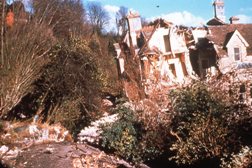
In the teeth of the gale
Lyme Regis, sitting astride the mouth of the River Buddle (or Lym) on an actively receding stretch of West Dorset coastline, has always faced considerable challenges from the twin threats of landslipping and erosion.
The earliest geotechnical projects undertaken at Lyme were designed to protect it from destruction by the sea.
First mentioned in the Domesday Book (1086), the town received its Royal Charter (adding the “Regis” to its name) in 1284, and during the 13th Century it developed into the major trading port and shipbuilding centre of Lyme Bay. Later, it became a fashionable resort, a kind of Bath-on-Sea, exemplified by the quaintly named “Ozone Terrace” - recalling a time when ground-level ozone was considered to be a good thing. The town soon developed a strong literary, artistic and scientific following. Jane Austen began the trend, with her final (and posthumously published) novel Persuasion, whose character Louisa Musgrove comes a nasty cropper on some treacherous steps - the so-called Granny’s Teeth – which stick out like corbels from Lyme’s most notable piece of geotechnical engineering, its curving 265m (870 ft) breakwater and harbour wall, known as The Cobb.
Austen’s book brought literary pilgrims throughout the 19th Century (Tennyson, visiting Lyme resident Francis Palgrave - of Golden Treasury fame - is said to have demanded to see the site of Miss Musgrove’s tumble immediately upon arrival), and it was this early tourist trade that allowed Lyme’s most famous daughter, Mary Anning, to earn a meagre living. Many of the well-to-do visitors (including Buckland and Conybeare) came to pursue their interest in the hottest scientific topic of the age – geology - and so enabled Mary to turn her fossil-finding talents to good commercial use.